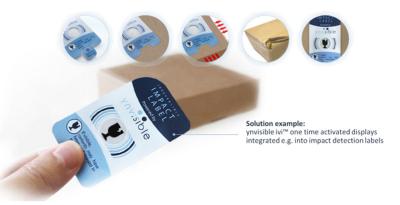Printed Electrochromics boldly goes where no display has gone before
This is a sponsored post by Ynvisible

Fig.1 Example use case for printed electrochromics: a shock detector smart label with an interactive printed interface.
Expanding Need for Simple Electronic Display Functionality
Rapid advances in the miniaturization and reduction of costs in computing, electronic sensing, and communications have allowed the integration of “smart†electronic functionality into almost everything. â€Intelligence†is now embedded into a wide range of everyday objects, and spread throughout our working and living environments. Much of this intelligence, data collection and transfer is hidden from the human senses, requiring little or no human involvement. But as the number of human daily touch points and interactions with smart devices grows, so too does the importance of user experience design and the role of displays.
Conventional electronic displays cannot be economically and sustainably applied into all smart objects and environments and can often times be functionality overkill for the simple display requirements of many everyday objects. Also, user experiences built around the need for extensive use of separate reading devices, e.g. RFID or Bluetooth readers in smart phones, can be increasingly challenging especially with the high number of distractions and strong competition for attention on mobile screens. Further with a doubling of screen time over the past four years among certain user demographics, there is also a growing sense of screen fatigue leading to people “detoxing†from light emitting screens while still valuing user interfaces that are useful yet unobtrusive.

